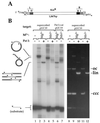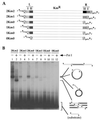Tn552 transposase catalyzes concerted strand transfer in vitro
- PMID: 9636151
- PMCID: PMC22612
- DOI: 10.1073/pnas.95.13.7345
Tn552 transposase catalyzes concerted strand transfer in vitro
Abstract
The Tn552 transposase, a member of the DDE superfamily of transposase and retroviral integrase proteins, has been expressed in soluble form. The purified protein performs concerted strand transfer in vitro, efficiently pairing two preprocessed transposon ends and inserting them into target DNA. For maximum efficiency, both participating DNA ends must contain the two adjacent transposase-binding sites that are the normal constituents of the Tn552 termini. As is the case with transposition in vivo, the insertions recovered from the reaction in vitro are flanked by repeats of a short target sequence, most frequently 6 bp. The reaction has stringent requirements for a divalent metal ion. Concerted strand transfer is most efficient with Mg2+. Although it stimulates strand transfer overall, Mn2+ promotes uncoupled, single-ended events at the expense of concerted insertions. The simplicity and efficiency of the Tn552 transposition system make it an attractive subject for structural and biochemical studies and a potentially useful genetic tool.
Figures





Similar articles
-
All three residues of the Tn 10 transposase DDE catalytic triad function in divalent metal ion binding.J Mol Biol. 1999 Jun 25;289(5):1195-206. doi: 10.1006/jmbi.1999.2837. J Mol Biol. 1999. PMID: 10373361
-
Multiple roles for divalent metal ions in DNA transposition: distinct stages of Tn10 transposition have different Mg2+ requirements.EMBO J. 1996 May 15;15(10):2547-55. EMBO J. 1996. PMID: 8665862 Free PMC article.
-
Dissecting Tn5 transposition using HIV-1 integrase diketoacid inhibitors.Biochemistry. 2007 Sep 25;46(38):10776-89. doi: 10.1021/bi7006542. Epub 2007 Aug 29. Biochemistry. 2007. PMID: 17725323
-
Tn5 as a model for understanding DNA transposition.Mol Microbiol. 2003 Mar;47(5):1199-206. doi: 10.1046/j.1365-2958.2003.03382.x. Mol Microbiol. 2003. PMID: 12603728 Review.
-
Structure/function insights into Tn5 transposition.Curr Opin Struct Biol. 2004 Feb;14(1):50-7. doi: 10.1016/j.sbi.2004.01.008. Curr Opin Struct Biol. 2004. PMID: 15102449 Review.
Cited by
-
Ferric enterochelin transport in Yersinia enterocolitica: molecular and evolutionary aspects.J Bacteriol. 1999 Oct;181(20):6387-95. doi: 10.1128/JB.181.20.6387-6395.1999. J Bacteriol. 1999. PMID: 10515929 Free PMC article.
-
Human Pso4 is a metnase (SETMAR)-binding partner that regulates metnase function in DNA repair.J Biol Chem. 2008 Apr 4;283(14):9023-30. doi: 10.1074/jbc.M800150200. Epub 2008 Feb 8. J Biol Chem. 2008. PMID: 18263876 Free PMC article.
-
Prototype Foamy Virus Integrase Displays Unique Biochemical Activities among Retroviral Integrases.Biomolecules. 2021 Dec 20;11(12):1910. doi: 10.3390/biom11121910. Biomolecules. 2021. PMID: 34944553 Free PMC article.
-
Functional analysis of the catalytic triad of the hAT-family transposase TcBuster.Plasmid. 2021 Mar;114:102554. doi: 10.1016/j.plasmid.2021.102554. Epub 2021 Jan 18. Plasmid. 2021. PMID: 33476638 Free PMC article.
-
In vitro transposition system for efficient generation of random mutants of Campylobacter jejuni.J Bacteriol. 2001 Apr;183(7):2384-8. doi: 10.1128/JB.183.7.2384-2388.2001. J Bacteriol. 2001. PMID: 11244083 Free PMC article.
References
Publication types
MeSH terms
Substances
Grants and funding
LinkOut - more resources
Full Text Sources
Other Literature Sources
Molecular Biology Databases
Research Materials

